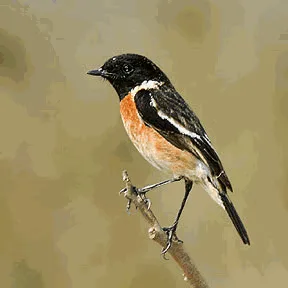 Siberian Stonechat Siberian Stonechat (Saxicola maura) [order] PASSERIFORMES | [family] Muscicapidae | [latin] Saxicola maura | [UK] Siberian Stonechat | [FR] Tarier de Siberie | [DE] Siberisches Schwarzkehlchen | [ES] Tarabilla comun siberiana | [NL] Aziatische Roodborsttapuit Subspecies
Physical charateristicsIt resembles the closely related Stonechat, but is typically paler, with a white rump and smaller orange breast. The summer male has black upperparts, usually lacking the brownish tones of Stonechat, a restricted orange throat and black head. It has white patches on the sides of its neck. The female has pale brown upperparts and head, and no white neck patches. The male has a clicking call like stones knocking together. The song is high and twittering like a Dunnock. Listen to the sound of Siberian Stonechat [audio:http://www.aviflevoland.nl/sounddb/S/Siberian Stonechat.mp3]
RangeEurasia : East Caucasus, Southeast Turkey and West Iran. Central Siberia, Central Asia, the Himalayas and West, Central China; HabitatBreeds in west Palearctic in middle and lower middle latitudes, in temperate, steppe, and Mediterranean zones, except for disjunct range of E race maura, which extends into boreal zone of north-west of the region. Absent from high-altitude mountainous regions in north of range, and from high forest, wetlands, and open expanses which are bare or have only sparse or low vegetation. Not affected by lack of standing or running water. Within these limitations, inhabits wide variety of dry plains and hillsides, often submarginal for agriculture, characterized by scattered bushes, shrubs, stones, walls, or fences, used as look-outs or song-posts commanding lower heathland, grassland, or bare patches.It breeds in open rough gorse, tussocks or heather. ReproductionBreeding starts in March-June in North-East Europe, mid April in South and Central Europe, mid May in former USSR. Nest site is on or close to ground in dense vegetation, at base of bush, in tussock, or low down in thick scrub. Nest is a loose, unwoven cup of dry grass stems and leaves, lined with hair and feathers sometimes with wool. 4-6 eggs, incubated by female for 13-14 days. Feeding habitsInsectivorous.Small and medium-sized insects and other invertebrates. Locates terrestrial prey from elevated perch, then flies, glides, or hops to ground, picking prey up on landing or while standing on ground. ConservationThis species has a large range, with an estimated global Extent of Occurrence of 1,000,000-10,000,000 km2. It has a large global population, including an estimated 4,000,000-9,200,000 individuals in Europe (BirdLife International in prep.). Global population trends have not been quantified, but the species is not believed to approach the thresholds for the population decline criterion of the IUCN Red List (i.e. declining more than 30% in ten years or three generations). For these reasons, the species is evaluated as Least Concern. MigrationMigrant to temperate Asia, towards Japan, Thailand and India. Rare vagrant W Europe and even Alaska Distribution map |
]]>
